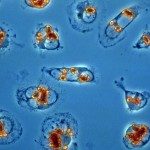Lien vers Pubmed [PMID] – 35732073
Lien DOI – 10.1021/acsinfecdis.2c00232
ACS Infect Dis 2022 Jul; 8(7): 1356-1366
Neglected tropical diseases (NTDs), including trypanosomiasis, leishmaniasis, and schistosomiasis, result in a significant burden in terms of morbidity and mortality worldwide every year. Current antiparasitic drugs suffer from several limitations such as toxicity, no efficacy toward all of the forms of the parasites’ life cycle, and/or induction of resistance. Histone-modifying enzymes play a crucial role in parasite growth and survival; thus, the use of epigenetic drugs has been suggested as a strategy for the treatment of NTDs. We tested structurally different HDACi 1-9, chosen from our in-house library or newly synthesized, against Trypanosoma cruzi, Leishmania spp, and Schistosoma mansoni. Among them, 4 emerged as the most potent against all of the tested parasites, but it was too toxic against host cells, hampering further studies. The retinoic 2′-aminoanilide 8 was less potent than 4 in all parasitic assays, but as its toxicity is considerably lower, it could be the starting structure for further development. In T. cruzi, compound 3 exhibited a single-digit micromolar inhibition of parasite growth combined with moderate toxicity. In S. mansoni, 4’s close analogs 17-20 were tested in new transformed schistosomula (NTS) and adult worms displaying high death induction against both parasite forms. Among them, 17 and 19 exhibited very low toxicity in human retinal pigment epithelial (RPE) cells, thus being promising compounds for further optimization.

